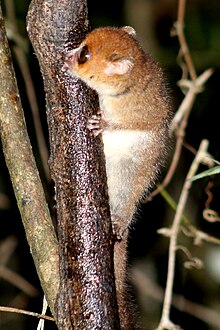Cheirogaleidae
| Cheirogaleidae | |
|---|---|

| |
| Brown mouse lemur (Microcebus rufus) | |
| Scientific classification | |
| Domain: | Eukaryota |
| Kingdom: | Animalia |
| Phylum: | Chordata |
| Class: | Mammalia |
| Order: | Primates |
| Suborder: | Strepsirrhini |
| Superfamily: | Lemuroidea |
| Family: | Cheirogaleidae Gray, 1873 |
| Type genus | |
Cheirogaleus
, 1812 | |
| Genera | |
| Synonyms[2] | |
| |
The Cheirogaleidae are the family of
Characteristics
Cheirogaleids are smaller than the other lemurs and, in fact, they are the smallest primates. They have soft, long fur, colored grey-brown to reddish on top, with a generally brighter underbelly. Typically, they have small ears, large, close-set eyes, and long hind legs. Like all strepsirrhines, they have fine claws at the second toe of the hind legs. They grow to a size of only 13 to 28 cm, with a tail that is very long, sometimes up to one and a half times as long as the body. They weigh no more than 500 grams, with some species weighing as little as 60 grams.[3]
Dwarf and mouse lemurs are
Their eyes possess a
Cheirogaleids are omnivores, eating fruits, flowers and leaves (and sometimes nectar), as well as insects, spiders, and small vertebrates.[3]
The females usually have three pairs of nipples. After a meager 60-day gestation, they will bear two to four (usually two or three) young. After five to six weeks, the young are weaned and become fully mature near the end of their first year or sometime in their second year, depending on the species. In human care, they can live for up to 15 years, although their life expectancy in the wild is probably significantly shorter.
Classification
The five genera of cheirogaleids contain 42 species.[4][5][6][7]
- Infraorder Lemuriformes
- Family Cheirogaleidae
- Genus Cheirogaleus: dwarf lemurs
- Cheirogaleus andysabini
- Cheirogaleus crossleyi
- Cheirogaleus grovesi
- Cheirogaleus lavasoensis
- Cheirogaleus major
- Cheirogaleus medius
- Cheirogaleus minusculus
- Cheirogaleus shethi
- Cheirogaleus sibreei
- Cheirogaleus thomasi[8]
- Genus
- Microcebus arnholdi[7]
- Microcebus berthae
- Microcebus bongolavensis[9]
- Microcebus boraha[10]
- Microcebus danfossi[9]
- Microcebus ganzhorni[10]
- Microcebus gerpi[11]
- Microcebus griseorufus
- Microcebus jollyae
- Jonah's mouse lemur, Microcebus jonahi
- Microcebus lehilahytsara
- Microcebus macarthurii[12]
- Microcebus manitatra[10]
- Microcebus margotmarshae[7]
- Microcebus mittermeieri
- Microcebus murinus
- Microcebus myoxinus
- Microcebus ravelobensis
- Microcebus rufus
- Microcebus sambiranensis
- Microcebus simmonsi
- Microcebus tavaratra[15]
- Genus
- Genus Mirza: giant mouse lemurs
- Mirza coquereli
- Mirza zaza
- Genus Allocebus
- Allocebus trichotis
- Genus Phaner: fork-marked lemurs
- Phaner furcifer
- Phaner pallescens
- Phaner parienti
- Phaner electromontis
- Family Cheirogaleidae
Footnotes
- a According to the letter of the International Code of Zoological Nomenclature, the correct name for this family should be Microcebidae, but the name Cheirogaleidae has been retained for stability.[2]
- Lokobe mouse lemur) was not among the additions, even though it was described in 2006. Therefore, its status as a species is still questionable.
References
- ^ "Checklist of CITES Species". CITES. UNEP-WCMC. Retrieved 18 March 2015.
- ^ ISBN 0-231-11013-8.
- ^ ISBN 0-87196-871-1.
- ^ S2CID 17614597.)
{{cite journal}}: CS1 maint: multiple names: authors list (link - S2CID 56920.
- S2CID 205328907.
- ^ S2CID 84533039. Archived from the original(PDF) on 2009-02-05.
- . Retrieved 8 September 2022.
- ^ S2CID 84701328. Retrieved 2007-12-10.
- ^ S2CID 43912903.
- S2CID 8473176.
- ^ "New Primate Species Discovered on Madagascar". Archived from the original on 2011-07-19. Retrieved 2008-07-15.
- ^ S2CID 17860060.
- ^ LiveScience.
- PMID 32716088.
